Earl Carroll Puts Swank into Sunset Boulevard
Tags: Entertainment Historic Hollywood
Built by renowned musical revue producer/impresario Earl Carroll in 1938, the lavish Streamline Moderne Earl Carroll Theatre at 6230 Sunset Blvd. has served as an exuberant entertainment venue for eight decades. Constructed at the height of Hollywood’s Golden Age as the entertainment mecca of the world, the glamorous nightclub served as an anchor for radio, television, and musical venues that soon followed it along this stretch of Sunset Boulevard and Vine Street.
Born in Pittsburgh, Pennsylvania in 1893, the multi-talented Earl Carroll blended razzmatazz, showmanship, and exoticism into a fantastical evening of musical theatre. Featuring statuesque, scantily clad showgirls, his shows offered a saucy, sexy walk on the wild side for conventional Angelenos.
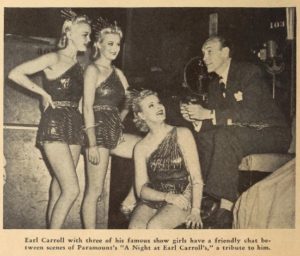
Earl Carroll with his world famous showgirls
Carroll hired renowned architect Gordon B. Kaufmann, designer of such iconic structures as the Los Angeles Times building, Santa Anita Park, and Hoover Dam, to formulate a sleek, upscale design for his nightclub. “The first structure of its kind in the nation” per the Los Angeles Times, the $500,000 building would combine dining, dancing, and stage shows under one roof.
 A 1940 dinner and show at the Earl Carroll. (photo credit: Marc Wanamaker, Bison Archives)
A 1940 dinner and show at the Earl Carroll. (photo credit: Marc Wanamaker, Bison Archives)
Kaufmann’s design emphasized the age of the automobile with its horizontal porte cochere leading to the parking lot, vertical neon lights adorning the exterior, and a 20-foot-tall neon profile of Carroll’s companion Beryl Wallace right in front. Over the entrance, the branding
legend “Through these portals pass the most beautiful girls in the world” promoted his fabulous spectacle. Later, giant plaques featuring autographs of stars also decorated the exterior.
 Fans admire the star plaques on the wall of the Earl Carroll Theatre in 1968 (photo credit - Marc Wanamaker, Bison Archives)
Fans admire the star plaques on the wall of the Earl Carroll Theatre in 1968 (photo credit - Marc Wanamaker, Bison Archives)
Adding an exotic element, Carroll hired Count Alexis de Sakhnoffsky, the originator of “streamlined design,” to add such special Art Deco touches as a black patent leather ceiling, colorful paneling, graceful fabric-lined walls, and neon tubes extending around the auditorium. A 15-foot tall nude statue of Wallace, a nude statue called the Goddess of Neon, and curved lines and bars evoled the stylishness of a Hollywood movie set.
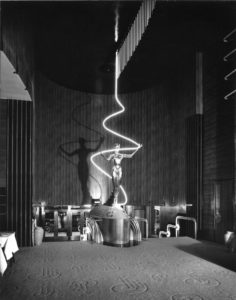 Lobby of the Earl Carroll Theatre in 1940 (photo credit - Mark Wanamaker, Bison Archives)
Lobby of the Earl Carroll Theatre in 1940 (photo credit - Mark Wanamaker, Bison Archives)
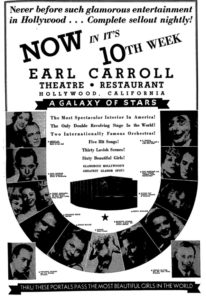 Celebrities quickly made the theatre one of Tinseltown’s premiere hot spots, luring average citizens to a night of flashy entertainment.
Celebrities quickly made the theatre one of Tinseltown’s premiere hot spots, luring average citizens to a night of flashy entertainment.
Thanks to its location in the center of Hollywood, movie studios soon employed the club as a filming location. On March 26, 1939, 20th Century-Fox employed the theatre to shoot scenes for a new Sonja Henie picture. Paramount shot the movie A Night at Earl Carroll’s inside the swanky club, also featuring appearances by Carroll, Wallace, and other showgirls. The Los Angeles Times also used the location for fashion shoots.
In 1946, Carroll intended to construct a 7,000 seat theatre, the world’s largest, nearby, but plans failed to come to completion. Just two years later, Carroll and Wallace died in an United Airlines crash in Aristes, Pennsylvania.
Over the next 65 years, the theatre saw many ownership changes. Texas industrialist Frank S. Hofnes purchased the middling business from the wrangling estates, opening “snappy, bright type of shows.” After quickly closing, CBS rented it as soundstage space for such shows as the City of Hope Telethon and Queen For a Day TV tapings.
Reopening as Frank Sennes’ Moulin Rouge on December 26, 1953, the supper club featured over the top stage shows replicating Paris’ sidewalk cafes. Entertainers such as Ella Fitzgerald, Liberace, and Peggy Lee performed, surrounded by lavishly dressed showgirls. With the opening of Las Vegas seven years later, business began sliding.
Temporary shows came and went, before the theatre was rechristened “Hullabaloo” in 1966 as a teenage nightclub. The plaques with star names on the front exterior were removed and replaced by those with autographs of such musical performers as Bo Diddley and Ike and
Tina Turner.
Within two years, the club was renamed “Aquarius” and decorated with an astrological motif. The musical “Hair” opened the theatre and the Dutch rock group the Fool created an outdoor mural called “The Aquarian Age” covering the entire front and west facades. The Los Angeles Times review noted that it featured “a panorama of cartoon goddesses and comic strip landscapes,” perfect for the times. Groups such as the Doors rocked its stage.
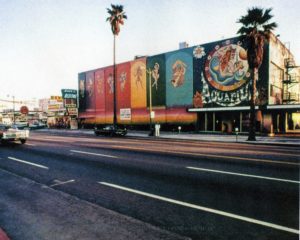 The exterior of the Aquarius Theatre, 1971 (photo credit - Marc Wanamaker)
The exterior of the Aquarius Theatre, 1971 (photo credit - Marc Wanamaker)
When the Age of Aquarius died in the 1970s, the Center Theatre Group-Mark Taper Forum took over management, bringing in the touring Broadway show Oh! Calcutta. Late in 1978 the renowned play Zoot Suit opened at the facility, later filmed for theatrical release. The 1980s TV show Star Search taped here before Filmex moved in, featuring eclectic film screenings and festivals.
Nickelodeon leased the theatre in 1997 for recording live-action television series for tweens and parents, before the Essex Property Trust bought the building and worked to gain it a Historic Cultural Moument nomination in 2016. The company has plans to restore the facade and neon, while looking for a tenant to reactivate the interior.
Film producer/director QuentinTarantino has recently recreated the Aquarius facade for scenes in his forthcoming film, Once Upon a Time in Hollywood. Set in 1969, the film tells the story of a faded TV actor and his stunt double working to make a name for themselves during the Helter Skelter reign of terror.
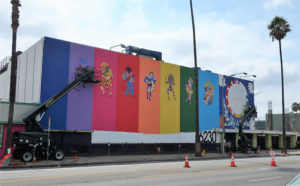 The theatre transported back to it's "Age of Aquarius" by Quentin Tarantino's team (photo credit: Bill Counter)
The theatre transported back to it's "Age of Aquarius" by Quentin Tarantino's team (photo credit: Bill Counter)
The Earl Carroll Theatre and its graceful, elegant lines still evoke the glamour and gorgeousness of old Hollywood.
Mary Mallory is the author of Hollywoodland and three other books. She also writes for the blog the LA Daily Mirror and serves on Hollywood Heritage’s Board of Directors.